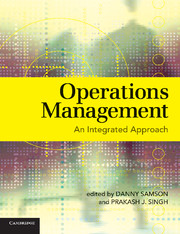Book contents
- Frontmatter
- Contents
- List of Contributors
- Preface
- Acknowledgements
- Part I Operations within Organisations – Building Blocks
- Part II Approaches to Understanding OM
- Part III Moving Forward with OM – Creating Competitive Advantage
- 8 Innovation, Technology and Knowledge Management
- 9 Quality Management in Operations
- 10 Operations Excellence
- Part IV Challenges and Opportunities in Operations
- Part V Case Studies
- Index
- References
8 - Innovation, Technology and Knowledge Management
Published online by Cambridge University Press: 05 June 2012
- Frontmatter
- Contents
- List of Contributors
- Preface
- Acknowledgements
- Part I Operations within Organisations – Building Blocks
- Part II Approaches to Understanding OM
- Part III Moving Forward with OM – Creating Competitive Advantage
- 8 Innovation, Technology and Knowledge Management
- 9 Quality Management in Operations
- 10 Operations Excellence
- Part IV Challenges and Opportunities in Operations
- Part V Case Studies
- Index
- References
Summary
Learning objectives
After reading this chapter you should be able to:
explain the meaning of innovation, in all the forms, states and rates that it takes place
explain why innovation is important to an organisation's performance
explain how innovation can be effectively managed
understand the issues involved in managing technology in organisations
understand how knowledge can be formally managed in organisations
explain how concepts of innovation, technology and knowledge are related.
Box 8.1: Management challenge: hybrid energy drive technology
Consider the example of Toyota and General Motors and the development of the hybrid energy drive technology for powering automobiles and improving fuel efficiency. In the mid to late 1990s, Toyota and General Motors were both investigating such technology and were about at the same early stage of development. Toyota redoubled its efforts into this radical innovation, while General Motors abandoned it for a number of reasons. The rest is history. Toyota invested over $1 billion in the technology. It used it first in the Prius and has now migrated this successful fuel efficient system into many of its other vehicles, from Lexus models to larger passenger vans. It is commercially producing this technology in Japan and more recently has been migrating it into the USA factories, in other words, scaling up the new technology and having it ‘main-streamed’. In contrast, General Motors has no equivalent technology and is lumbering towards a different technology, and it has certainly lost any potential for many years to come to be a technological leader in this field. […]
- Type
- Chapter
- Information
- Operations ManagementAn Integrated Approach, pp. 225 - 250Publisher: Cambridge University PressPrint publication year: 2008
References
- 4
- Cited by



